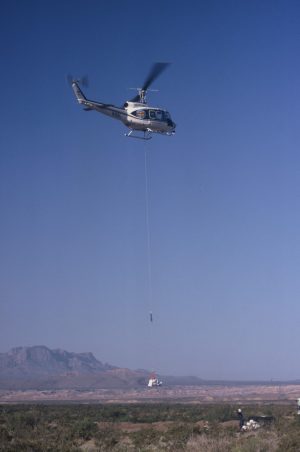
Lajitas Dinosaurs
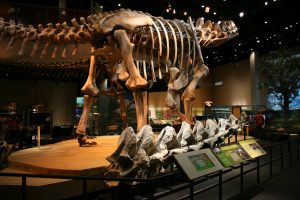
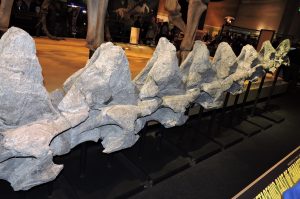
Remembers Dr Homer Montgomery:
“How often does this kind of thing happen? What other university has students with this sort of, shall we say, resourcefulness?
Searching for dinosaur fossils in 117 degree heat in Big Bend National Park accompanied Dana Biasatti (currently a research scientist) and Eric Venski (owns an English language school in Tokyo) from my ‘Age of Dinosaurs’ class, Dana crackled on the radio with news of a discovery. She found a bone bed containing three juvenile Alamosaurus dinosaurs.
This fascinating discovery led to a great deal of excavation in the Park (with the proper Federal permits). At lunch on a particularly difficult day of digging, I asked Dana to find another dinosaur that would be easier to excavate. A couple of hours later she returned, and that discovery would become the giant Alamosaurus at the Perot Museum. Numerous UTD students assisted in that excavation. Many are now amazingly successful (such as Vas Stanescu who is a program director at Stanford University).
Bell Helicopter flew the airlift of that string of cervical vertebra (one bone weighed approximately 1100 pounds). No charge. The connection with Bell Helicopter was initiated by yet another UTD student.”
The UTD Research and Education Project Collaborative with the Lajitas Resort in West Texas
Our mission
Following a long history of UTD faculty and students working and studying in Big Bend National Park and nearby areas that includes the discovery and airlift of the Dallas Perot Museum Alamosaurus dinosaur, we are presently working to define the paleoecology of the Boquillas Formation seafloor for both scientific publication and to provide the most accurate reconstruction possible for a major seafloor exhibit at a museum to be built at the Lajitas Resort.
Faculty and student involvement
Several faculty and more than 400 UTD students have participated in our projects in the Big Bend area. Each trip yields interesting findings. During a recent visit we made two discoveries. One was a promising string of mosasaur vertebrae that extend beneath a small hill that left us wondering how much of the skeleton might be there (image below). The second find was a collection of fish vertebrae in the region where the stomach of a large mosasaur would have been. Once identified, the vertebrae will provide evidence for the composition of the last meal of this great predatory beast (image below). Research associated with our various expeditions is commonly incorporated into coursework at UTD.
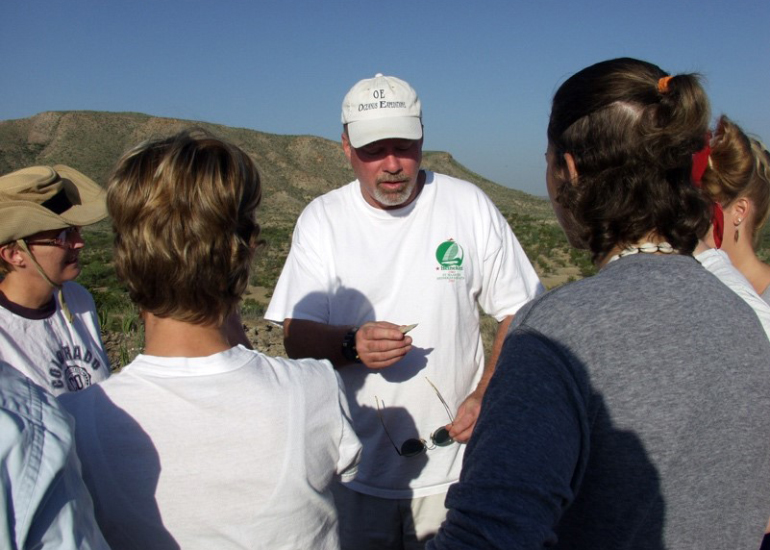
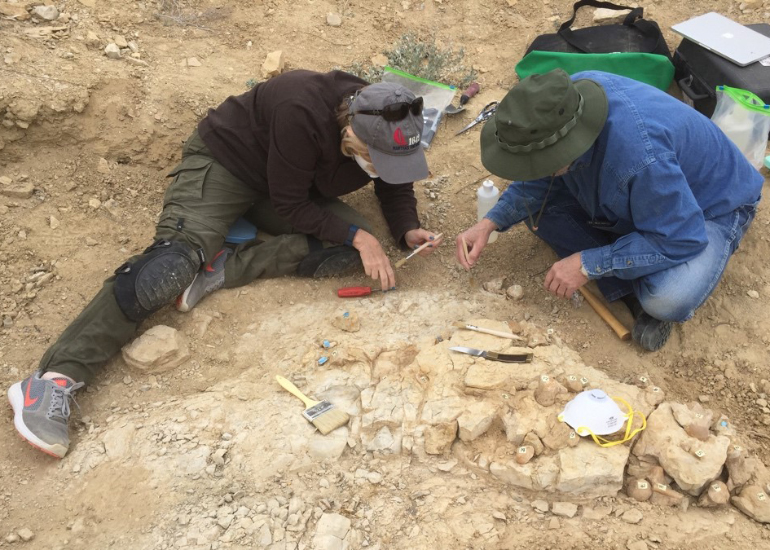
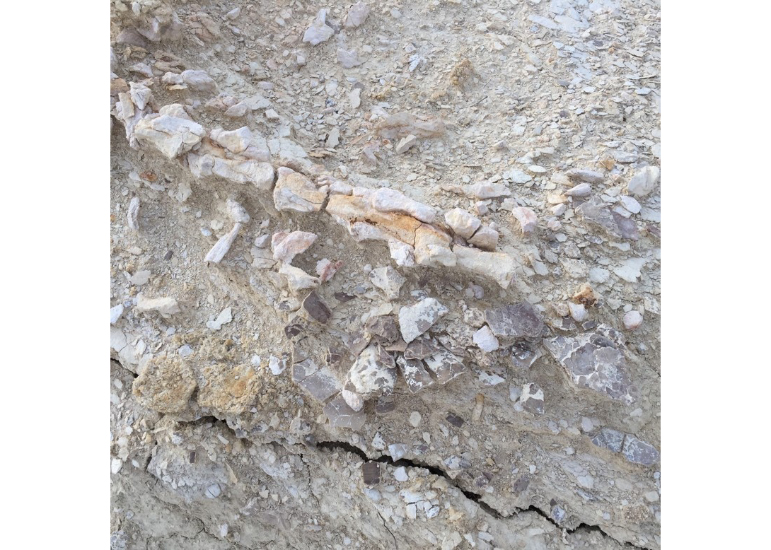
Current research
Dr. Montgomery, a paleontologist, is completing work on his third Big Bend paleoecology paper each of which is focused on richly fossiliferous intervals at the end of the Age of Dinosaurs. Each site is located near Big Bend National Park, the region of many of our previous discoveries including the giant Alamosaurus sanjuaneneis that prominently resides in the Perot Museum of Dallas. The first two papers were published in the journal Palaios. In association with co-authors, one of which is a UTeach Dallas student, this third work details the invertebrate and vertebrate faunas of the ancient Boquillas sea floor.
The field of giant clams in our present study area in the Boquillas Formation is impressive. The most complete specimens are being collected. At least one of these will become a Lajitas museum specimen.

Preparing a giant clam for removal, reconstruction, and preservation. A thick encrustation of the mutualistic oyster Pseudoperna congesta is evident on the external surfaces of both valves of this Platyceramus platinus. This specimen is approximately 120 cm in diameter.

A detailed analysis of the foraminifers in the enclosing rocks is in the works. They strongly suggest a deep marine environment (> 200mdepth). Preston Dozier, a UTeach Dallas student, is studying the open question of the life position of these giant clams. She is also working to determine the ages at death of both the clams and of the encrusting oysters. Thin sections and acetate peels provide these data.
Dr. Dana Biasatti, a geochemist at Notre Dame, is providing isotopic details that among other information will determine water temperatures during the lives of these clams. Finally, Shawn Hamm, an expert on extinct sharks, is writing the section about the role of predators at this site. This paleoecological analysis will be published when complete.
Museum worthy fossils for display
Although difficult to immediately resolve, there are jaws with teeth in the photo below. The bottle contains Butvar resin, a vital sealer and adhesive used when working with fragile fossils. The preserved parts of this marine reptile are patiently being reassembled. For display, a shadow box with flat black interior and precise LED lighting is being considered. The skeletal elements will be positioned in 3D space as they were in life with missing components simply missing. Some imagination will be required in order for the viewer to “flesh out” the creature.

Educational activities
SME faculty are deeply involved in informal education and outreach to STEM undergraduate and graduate students. We also want our students to understand the complicated process of conducting original scientific research, a process that few teachers actually experience or understand.
We have now instituted graduate thesis work that is two-fold. The first part is to participate in authentic scientific research. The second part is to move primary research into the classroom mostly via Problem Based Learning methodology. Students will merge the two components in innovative ways. This effort follows published work between Dr. Montgomery and UTeach Master Teacher Katie Donaldson in bringing PBL methodologies to Montgomery’s Honors Age of Dinosaurs course. We expect these students to submit manuscripts to science and/or education journals.
Support
The Lajitas Resort supports our work by providing flights, lodging, and equipment that even includes a backhoe. Because of this support, fossils are being discovered, excavated, and preserved for posterity. Most will eventually be on display to visitors.


Publication associated with Big Bend and Lajitas
- Main, D., Montgomery, H. Biasatti, D and Bennett, G., 1999, The titanosaurid Alamosaurus sanjuanensis (Sauropoda: Dinosauria) from the Javelina formation of Big Bend, Texas. Geological Society of America, South-central Section, 33rd Annual Meeting, Abstracts with Programs – Geological Society of America, v. 31, p. 12, February, Lubbock, TX
- Fiorillo, A, Main, D., Bhattacharya, J., and Montgomery, H., 2000, Paleoecological analysis of a Juvenile Titanosaurid locality with the Javelina Formation of Big Bend National Park. National Park Service Research, v. 4.
- Main, D. and Montgomery, H., 2000, Paleoecology of a titanosaurid sauropod dinosaur locality within the Javelina Formation of Big Bend National Park. Texas. Geological Society of America, South-central Section, 34th annual meeting, Abstracts with Programs – Geological Society of America, Meeting: April, Fayetteville, AK, v. 32, p. 34.
- Montgomery, H., 2001, How fast did dinosaurs run? The Texas Science Teacher, v. 30(1), p. 16-19. The Texas Science Teacher, v. 31, p. 28-31.
- Montgomery, H., 2004, Effective geological fieldwork as part of a graduate program for practicing science teachers. The Texas Science Teacher, v. 33, p. 16-23.
- Montgomery, H., and Barnes, K., 2012, Paleolimnology of uppermost Cretaceous lacustrine deposits in West Texas. Palaios, v. 27, p. 386-394.
- Montgomery, H. and Fiorillo, A, 2001, Depositional setting and paleoecological significance of a new sauropod bonebed in the Javelina Formation (Cretaceous) of Big Bend National Park, Texas. Geological Society of America, 35th annual meeting, Abstracts with Programs, v. 33, p. 196, October, Boston, MA.
- Fiorillo, A. and Montgomery, H., 2001, Depositional setting and paleoecological significance of a new sauropod bonebed in the Javelina Formation (Cretaceous) of Big Bend National Park, Texas. Society of Vertebrate Paleontology, 61st annual meeting, Abstracts with Papers, v. 21, p. 49A, October, Boseman, Montana.
- Montgomery, H., 2002, Texas science teachers and earth science issues in the Big Bend Region. Geological Society of America, South-Central Section Meeting, Abstracts with Programs, April, Sul Ross University, Alpine, Texas, v. 34(3), p. 10. Montgomery, H., 2002, A constructivist approach to field geology for science teachers: Geological Society of America, 36th annual meeting, Abstracts with Programs. October, Denver, CO.
- Main, D., Fiorillo, A., Montgomery, H., 2002, New methods in paleontology; GPR mapping and excavation of a titanosaurid (Dinosauria, Sauropoda) bonebed in Big Bend National Park. Geological Society of America, South-Central Section, 36th annual Meeting. Abstracts with Programs, v. 34, p. 10.
- Montgomery, H., 2009, Paleolimnology of two dinosaur watering holes in west Texas. Geological Society of America Abstracts with Programs, 41, p. 34
- Montgomery, H., 2012, A new microvertebrate local fauna in the Aguja Formation, Texas. Geological Society of America Abstracts with Programs, v. 44, p. 36.
- Montgomery, H., 2012, Mysteries of giant Platyceramus of the Boquillas Formation sea floor. Geological Society of America Abstracts with Programs, v. 44, p. 30.
- Montgomery, H., and Barnes, K., 2012, Paleolimnology of uppermost Cretaceous lacustrine deposits in West Texas. Palaios, v. 27, p. 386-394. Montgomery, H., and Donaldson, K., 2013, Teaching paleontology and paleoecology in a problem based learning format. Society of America Abstracts with Programs, v. 45, p. 314.
- Montgomery, H., and Donaldson, K., 2014, Using problem-based learning to deliver a more authentic experience in paleontology. Journal of Geoscience Education, v. 62, p. 714-724.
- Montgomery, H., 2015, Coprolites of predator and prey dinosaurs in the Aguja Formation of Trans-Pecos Texas. Geological Society of America Abstracts with Programs. v. 47, p. 347.
- Montgomery, H., and Clark, S., 2016, Paleoecology of the Gaddis site in the Upper Cretaceous Aguja Formation, Terlingua, Texas. Palaios, v. 31, p. 347-357.
